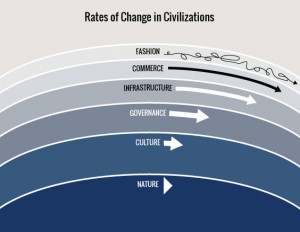Time can be an overlooked element in business. Time can be an enemy, and time can be a friend. Understanding the impact of time on your business separates the best business minds from the rest. Time affects the pace of change for components of your business, your industry; and time affects our neighborhoods and cities, our economy, our government, and our environment. These ideas struck me as I read Steward Brand’s book, Clock of the Long Now, and watched his recent presentation at an Evernote conference.
Different paces of change
Brand uses this graphic to explain his idea that resilient systems (and resilient companies) have components with different paces of change. The interaction among these components provides stability and the ability to incorporate shocks. His components from fast change to slow change are: fashion, commerce, infrastructure, governance, culture, nature.
Brand writes, “How do ecological systems absorb and incorporate shocks? The answer appears to lie in the relationship between components in a system that have different change rates and different scales of size. Instead of breaking under stress like something brittle these systems yield as if they were malleable. Some parts respond quickly to the shock, allowing slower parts to ignore the shock and maintain their steady duties of system continuity. The combination of fast and slow components make the system resilient, along with the way the differently paced parts affect each other. Fast learns, slow remembers. Fast proposes, slow disposes. Fast is discontinuous, slow is continuous. Fast and small instructs slow and big by accrued innovation and occasional revolution. Slow and big controls small and fast by constraint and constancy. Fast gets all our attention, slow has all the power. All durable dynamic systems have this sort of structure; it is what makes them adaptable and robust.”
In business, it often takes a while to get alignment and coordination among the different layers in the stack of activities — such as the business model, customers, investors, employees, systems and processes. The pace of change on some of these can be quick, and some will be slow. Having the ability to absorb and incorporate shocks and new innovations while maintaining continuity with your most important values and competitive advantages helps make resilient companies.
Time (and its relation to the pace of change) is the friend of a great business, and the enemy of a poor business. Time ticking past while a great business compounds in value is a wonderful thing. Time ticking past as a company burns cash or a deadline looms is stressful. It is worth thinking about how to construct your business so that time (and the pace of change in your business or industry) is your friend.
Resilient rates of change
I liked this quote, so I wanted to include it. Brand includes this quote by mathematician and scientist, Freeman Dyson, with a similar idea on how different rates of change impact humanity.
“The destiny of our species is shaped by the imperatives of survival on six distinct time scales. To survive means to compete successfully on all six time scales. But the unit of survival is different at each of the six time scales. On a time scale of years, the unit is the individual. On a time scale of decades, the unit is the family. On a time scale of centuries, the unit is the tribe or nation. On a time scale of millennnia, the unit is the culture. On a time scale of tens of millennia, the unit is the species. On a time scale of eons, the unit is the whole web of life on our planet. Every human being is the product of adaptation to the demands of all six time scales. That is why conflicting loyalties are deep in our nature. In order to survive, we have needed to be loyal to ourselves, to our families, to our tribes, to our cultures, to our species, to our planet. If our psychological impulses are complicated, it is because they were shaped by complicated and conflicting demands.”



 I am an investor at Greybull Stewardship, an
I am an investor at Greybull Stewardship, an 
 Sign Up
Sign Up RSS Feed
RSS Feed